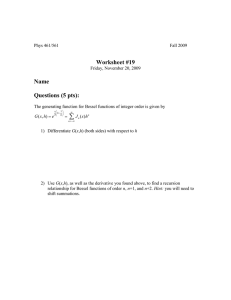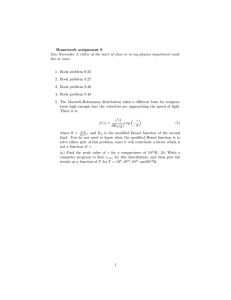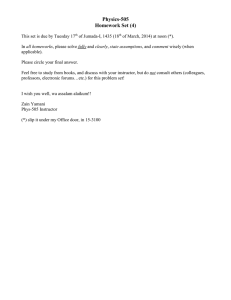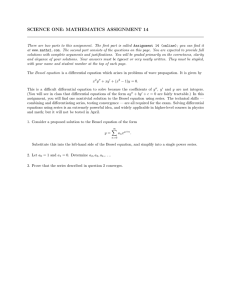PAM-N Eye Diagrams
advertisement
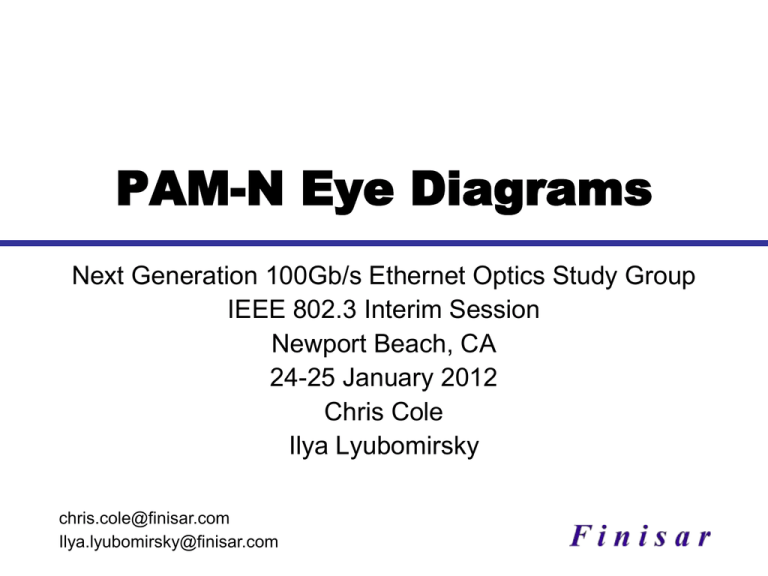
PAM-N Eye Diagrams Next Generation 100Gb/s Ethernet Optics Study Group IEEE 802.3 Interim Session Newport Beach, CA 24-25 January 2012 Chris Cole Ilya Lyubomirsky chris.cole@finisar.com Ilya.lyubomirsky@finisar.com Outline ■ Matlab Model ■ 7ps Rise/Fall Time Eye Diagrams ■ 20ps Rise/Fall Time Eye Diagrams ■ Observations ■ Appendix 24-25 January 2012 2 Matlab Model PAM-N Symbols Rect Pulse 4-pole Bessel LPF Eye Diagram ■ Simulation variables: N (in PAM-N), data rate, rise/fall time ■ Tr defined as 20% to 80% (Tf as 80% to 20%) ■ Bessel Filter BW adjusted to match Target response eye diagram rise/fall time (model ER = α since no modulator) 1 0.9 Square Amplitude 0.8 0.7 0.6 Ex: Filter BW for Tr/Tf = 20ps 0.5 0.4 0.3 Appendix show Bessel LPF matching examples 0.2 0.1 0 0 5 10 15 20 25 30 Frequency (GHz) 24-25 January 2012 3 PAM-8 34.375Gb/s Tr/f = 6.8ps Er = α Target response: PAM-8 Eye Diagram bhoja_01_0112 p.10 24-25 January 2012 4 PAM-16 25.781Gb/s Tr/f = 12ps Er = α Tr/f changed from 6.8ps to 12ps per request for correction from the floor Target response: 2nd PAM-16 Eye Diagram bhoja_01_0112 p.22 24-25 January 2012 5 NRZ 25.781Gb/s Tr/f = 6.8ps Er = α 24-25 January 2012 6 NRZ 103.125Gb/s Tr/f = 6.8ps Er = α 24-25 January 2012 7 Si Modulator Tr/f Reported Results ■ L. Chen, et al., (ALU Bell Labs), “… Silicon … Modulator …”, Optics Express, Vol. 19, No. 26, pp. 946-951 (2011) Tr/f = ~20ps ER = 7.2dB (Tr/f = 18ps Bessel 4p LPF best match) ■ K. Ogawa, et al., (Fujikura), “Silicon MZ Modulator …”, ECOC 2011 Tr/f = ~22ps ER = ~10dB (Tr/f = 22ps Bessel 4p LPF best match) ■ J. Rosenberg, et al., (IBM), “… Silicon … Modulator”, CLEO 2011 Tr/f = ~22ps ER = 1-4dB (Tr/f = 20ps Bessel 4p LPF best match) ■ A Narasimha, et al., (Luxtera), “… Silicon Modulator”, OFC 2008 Tr/f = ~21ps ER = ~4dB (Tr/f = 18ps Bessel LPF best match) ■ L. Liao, et al., (Intel), “… silicon modulator”, Electronics Letters 2007 Tr/f = ~15ps ER = 1.1dB 24-25 January 2012 (Tr/f = 15ps Bessel LPF best match) 8 NRZ 25.781Gb/s Tr/f = 20ps Er = α 24-25 January 2012 9 PAM-8 34.375Gb/s Tr/f = 20ps Er = α 24-25 January 2012 10 PAM-16 25.781Gb/s Tr/f = 20ps Er = α 24-25 January 2012 11 Observations ■ PAM-N technical feasibility is primarily determined by MZ Si Modulator performance ■ PAM-N economic feasibility is driven by MZ Si Modulator yield and IC complexity and power consumption ■ Publically reported Si Modulator performance suggests PAM-8 and PAM-16 modulation is not yet feasible for 100Gb/s duplex SMF applications ■ Significantly more study is required to understand PAM-8 and PAM-16 performance limitations before use in support of 100Gb/s duplex SMF Technical Feasibility 24-25 January 2012 12 Appendix: Ex. PAM Study to LPF Matching ■ J. Bhoja, et al., “Study of PAM modulation for 100GE over a single laser”, IEEE 802.3 Interim Meeting, Jan. 24th-25th, 2012 ■ Finisar Matlab Model Bessel LPF best eye match Tr/f = 6.8ps Bessel LPF PAM-8 35 Gb/s 6.8ps 24-25 January 2012 13 Appendix: Ex. Reference to LPF Matching ■ J. Rosenberg, et al., (IBM), “Low-Power 30 Gbps Silicon Microring Modulator”, PDPB9, OSA/CLEO 2011 ■ IBM Reference Reported Tr/f = 22ps ■ Finisar Matlab Model Bessel LPF best eye match Tr/f = 20ps Bessel LPF NRZ 20 Gb/s 20ps 1.2 1 0.8 0.6 0.4 0.2 0 -0.2 0 0.1 0.2 0.3 0.4 0.5 0.6 0.7 0.8 0.9 1 -10 Time (s) 24-25 January 2012 14 x 10
